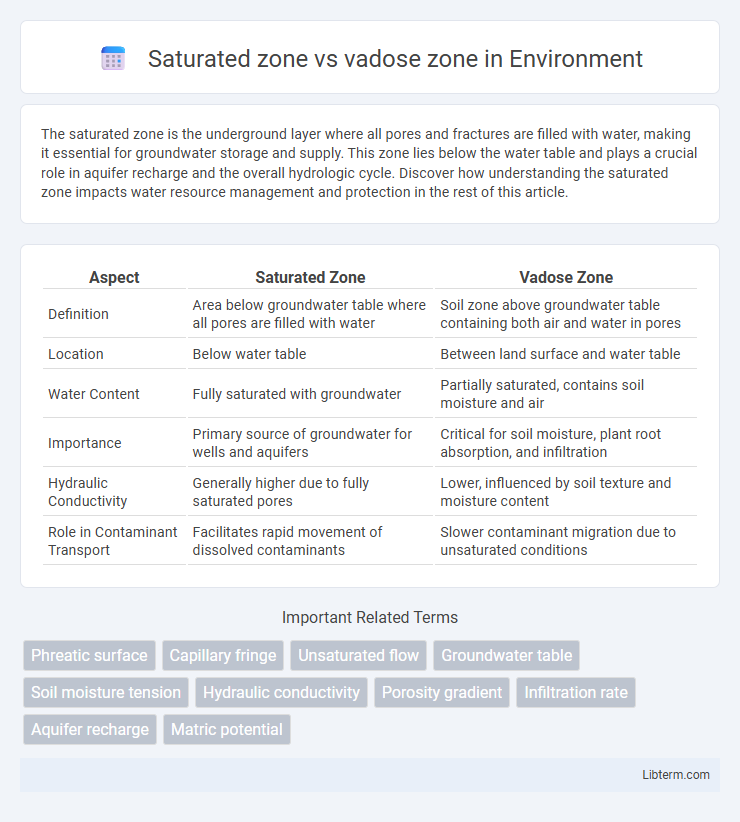The saturated zone is the underground layer where all pores and fractures are filled with water, making it essential for groundwater storage and supply. This zone lies below the water table and plays a crucial role in aquifer recharge and the overall hydrologic cycle. Discover how understanding the saturated zone impacts water resource management and protection in the rest of this article.
Table of Comparison
| Aspect | Saturated Zone | Vadose Zone |
|---|---|---|
| Definition | Area below groundwater table where all pores are filled with water | Soil zone above groundwater table containing both air and water in pores |
| Location | Below water table | Between land surface and water table |
| Water Content | Fully saturated with groundwater | Partially saturated, contains soil moisture and air |
| Importance | Primary source of groundwater for wells and aquifers | Critical for soil moisture, plant root absorption, and infiltration |
| Hydraulic Conductivity | Generally higher due to fully saturated pores | Lower, influenced by soil texture and moisture content |
| Role in Contaminant Transport | Facilitates rapid movement of dissolved contaminants | Slower contaminant migration due to unsaturated conditions |
Introduction to Subsurface Zones
The subsurface environment is divided into the saturated zone, where all soil pores are fully filled with water, and the vadose zone, located above it, containing both air and water within the soil pores. The saturated zone, also known as the phreatic zone, is crucial for groundwater storage and aquifer recharge, while the vadose zone influences soil moisture dynamics and unsaturated flow processes. Understanding these zones is fundamental for groundwater management, contamination studies, and hydrological modeling.
Defining the Vadose Zone
The vadose zone, also known as the unsaturated zone, is the subsurface area between the land surface and the groundwater table where soil pores contain both air and water. This zone plays a crucial role in controlling water infiltration, soil moisture dynamics, and contaminant transport before reaching the saturated zone. Understanding the vadose zone's properties aids in groundwater recharge assessment and environmental management.
Characteristics of the Saturated Zone
The saturated zone is the region below the Earth's surface where all the pore spaces in soil and rock are completely filled with water, ensuring a continuous supply of groundwater. This zone contrasts with the vadose zone above it, where pores contain both air and water, resulting in unsaturated conditions. In the saturated zone, hydraulic conductivity is high due to full pore saturation, facilitating the unimpeded flow of groundwater essential for aquifer recharge and water resource management.
Key Differences Between Vadose and Saturated Zones
The vadose zone, located above the water table, contains both air and water within its pores, whereas the saturated zone lies below the water table and its pores are fully filled with water. Water movement in the vadose zone primarily occurs through unsaturated flow driven by capillary forces, while in the saturated zone, groundwater flows under the influence of hydraulic gradients. These distinctions critically affect groundwater recharge, contaminant transport, and soil moisture dynamics in hydrogeological studies.
Water Movement in the Vadose Zone
Water movement in the vadose zone occurs mainly through unsaturated flow, driven by capillary forces and soil moisture gradients, contrasting with saturated flow in the saturated zone where pore spaces are fully filled with water. In the vadose zone, water infiltrates downward from the surface, percolating through air-filled pores, which affects evaporation, plant water uptake, and contaminant transport. Understanding this zone's hydraulic conductivity and soil texture is crucial for managing groundwater recharge and predicting soil moisture dynamics.
Groundwater Flow in the Saturated Zone
Groundwater flow in the saturated zone occurs where all pore spaces in soil and rock are fully filled with water, allowing for continuous movement through interconnected pores. This zone lies below the vadose zone, which contains both air and water within its pores and primarily supports unsaturated flow. The saturated zone's hydraulic conductivity and gradient directly influence the velocity and direction of groundwater flow, essential for aquifer recharge and subsurface water transport.
Importance in Groundwater Recharge
The saturated zone is crucial for groundwater recharge as it contains fully water-saturated soil and rock where groundwater accumulates and stores. The vadose zone lies above the saturated zone and plays a vital role in regulating the movement of water from the surface to the saturated zone through infiltration and percolation processes. Efficient groundwater recharge depends on the vadose zone's ability to transmit water downward while filtering contaminants before reaching the saturated zone aquifers.
Impact on Soil and Water Quality
The saturated zone, containing fully water-filled pores, plays a critical role in groundwater storage and influences the transport of contaminants, directly affecting water quality. The vadose zone, or unsaturated zone, moderates soil moisture availability and nutrient cycling, impacting soil health and the filtration of pollutants before they reach groundwater. Differences in porosity and permeability between these zones determine the retention and movement of chemicals, thus shaping both soil fertility and groundwater contamination risks.
Environmental and Engineering Applications
The saturated zone, where all soil pores are filled with water, plays a critical role in groundwater recharge and contaminant transport modeling essential for environmental risk assessments. In contrast, the vadose zone contains both air and water in the soil pores, influencing unsaturated flow dynamics and biogeochemical processes vital for irrigation management and soil remediation strategies. Engineering applications such as landfill design and foundation stability rely on understanding moisture movement and retention differences between these zones to ensure structural integrity and environmental protection.
Summary: Choosing the Right Zone for Study
Selecting between the saturated zone and vadose zone for study depends on the research goals and hydrogeological context. The saturated zone contains groundwater fully saturating soil pores, critical for analyzing aquifer recharge, groundwater quality, and flow dynamics. The vadose zone, with partially saturated pores above the water table, is essential for understanding soil moisture movement, contaminant transport, and unsaturated zone hydrology influencing surface water interactions.
Saturated zone Infographic

 libterm.com
libterm.com